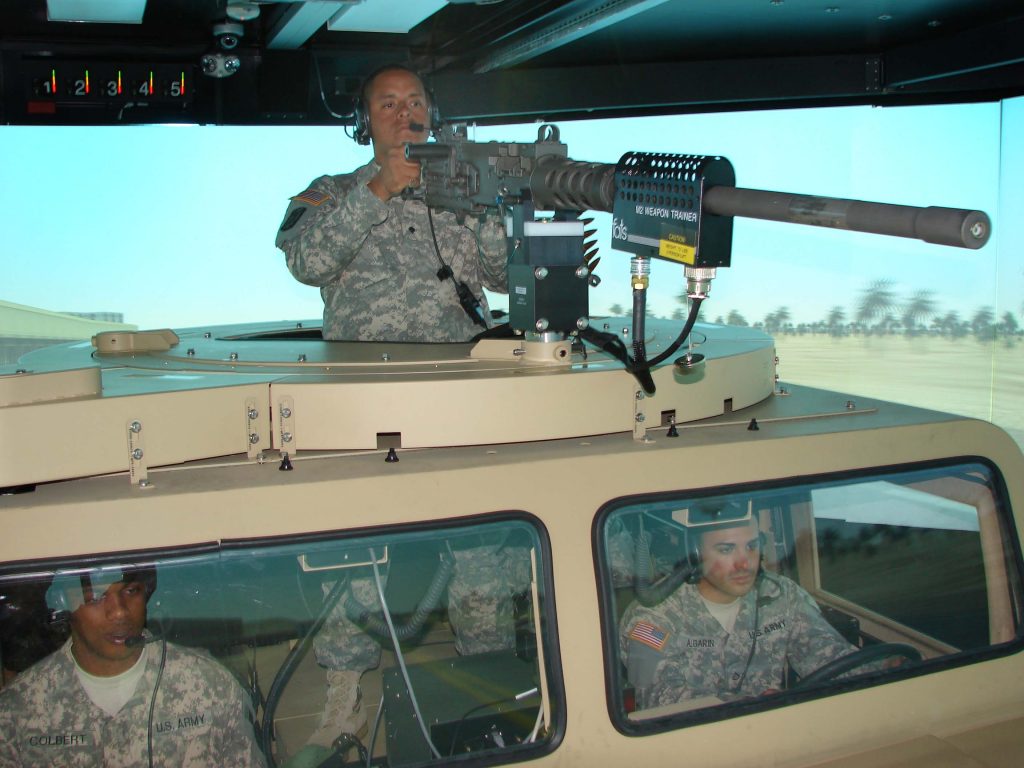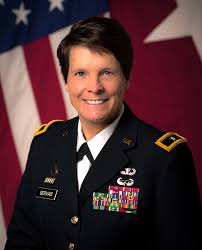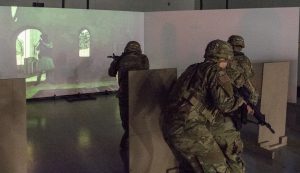
One of the many stand-alone training simulations the Army plans to replace, a convoy sim called RVTT.
UPDATED with additional detail WASHINGTON: Next month, the Army will award key contracts for prototypes of a radically new set of networked training simulations, the two-star chief of the service’s training modernization task force told Breaking Defense.
“We were using 1980s and ’90s technology for our air and ground platforms,” Maj. Gen. Maria Gervais told me in an interview. In the decades since the Army bought those simulators, the commercial gaming industry has gone from the very first Pokémon game to immersive war stories like Call of Duty and virtual-reality headsets like the Oculus Rift. Sure, the Army requires a very different balance of realism versus fun, but “we can take advantage of the virtual and gaming industry,” Gervais said, as well as commercially available map data detailing potential conflict zones.
So, what’s happening?
- The Army will award at least one and possibly multiple contracts next month to develop a Common Synthetic Environment, the underlying digital foundation to be used by a wide range of simulators. It’ll provide everything from the virtual terrain to fight over, to the physics models that determine hits, misses and explosions, to the management tools that let soldiers design their own training scenarios, record how they play out, and put together after-action critiques.
- Later in June, the Army will contract for the actual aircraft and ground vehicle simulators that the crews will sit in to train. Instead of building different simulators for different kinds vehicle, the idea is to build a single Reconfigurable Virtual Collective Trainer (RVCT) Ground for armored vehicles that can be set up as an M1 tank, M2 troop carrier, or even future Next Generation Combat Vehicles yet to be designed. Likewise there’ll be a single RVCT-Air that can be reconfigured to simulate different kinds of aircraft.
- The Army and Marines are already fielding a Squad Advanced Marksmanship Trainer for foot troops. SAM-T, which came out of the former Sec. Mattis’s Close Combat Lethality Task Force, immerses the users in a virtual environment by projecting it all around them on large screens. But in the long run, the Army wants a Soldier/Squad Virtual Trainer that lets soldiers wearing augmented reality goggles connect to the Common Synthetic Environment. That will allow infantry squads to train alongside vehicle crews in complex virtual battles. UPDATE: The Army will award a contract to further develop the SSVT in June as well, but it’s not as far along as the vehicle systems.
All of these contracts will use the Other Transaction Authority (OTA) process to bypass the laborious bureaucracy of the standard defense acquisition process. The goal? To help encourage tech-sector innovators not used to doing business with the Defense Department. All the vendors will be required to conform to a common set of standards the Army is developing over the next six to nine months, she said: “We don’t want anything that’s proprietary.” That approach, called modular open architecture, should make it possible to plug-and-play products from different companies, much the way an iPhone can take apps from any vendor that meets Apple’s standards.
If all this works, it’ll be a huge improvement over the current hodgepodge of more than 100 often-incompatible training systems. A particularly tricky problem: since different simulators for different weapons systems were built at different times and often by different companies, it can be extremely difficult to network them together so the crews of different kinds of vehicles can practice fighting in a combined arms team. But that kind of cooperation is essential to learning and practicing real-life tactics.
In one particularly glaring case, Gervais once told me, helicopter pilots thought they were well-hidden behind hills and trees, but anti-aircraft gunners in the same virtual battle could see the helicopters hovering in the open and shot them down. Why? Because the two types of simulators used incompatible terrain databases.
The new simulators should also be smaller, cheaper, and easier for soldiers to operate without specialist contractor support, Gervais said. While the old clunkers had to be housed in warehouse-like facilities staffed by technical support contractors, with combat units having to wait their turn to train, the new sims could be issued to individual tactical units to practice whenever they want. And they could be ten networked together with other units for larger-scale virtual exercises.
Troops have already gotten their hands on many of the potential competitors’ simulators, Gervais said, in a series of more than 20 “soldier touchpoints.” Potential reconfigurable ground trainers, in particular, got checked out by tank, Bradley, and Stryker soldiers at Fort Riley, Kansas. Army helicopter crews from Fort Carson, Colorado are now looking at potential air trainers.(The equipment for these events was also brought in under OTA contracts). Meanwhile Gervais’s Cross Functional Team is poring over software options at their new Orlando headquarters.
When the soldiers saw problems, such as insufficient realism, they quickly reported them to Gervais’s team and the vendor representatives working right alongside them to get things fixed ASAP. They’re also coming up with ways to use the technology neither the manufacturers nor their superiors had thought of. The younger officers and enlisted she watched try out the tech, Gervais told me, were “very comfortable with it…. They see the benefit of using it immediately.”
That said, it won’t be until late 2021 that the Army issues the first full-up systems, fielding them to combat battalions at five locations to be determined. That’s lightning fast for a military procurement program, but slow for Silicon Valley: Can we go any faster?
“When we go into production, we can shorten that timeline,” Gervais said — but that’ll mostly speed up fielding to other units after 2021. Truncating the testing and evaluation before the system’s ready to field raises the risk of buying the wrong thing, she said.
“What I want to do make sure we have soldier touchpoints in place,” she said. “What I don’t want to do is shorten the evaluation.”
Yes, the Army’s in a hurry, but the one thing Gervais will not shortcut is giving real soldiers a chance to give feedback on the gear they’re going to use.
Updated 4:15 pm with additional details.
From F-16s to NATO, Argentina’s moves tilt West, but ties to China to last
There are flashpoints to watch as Argentina navigates its future between the polar attractions of Washington and Beijing, including future defense deals and a deep space facility.




























